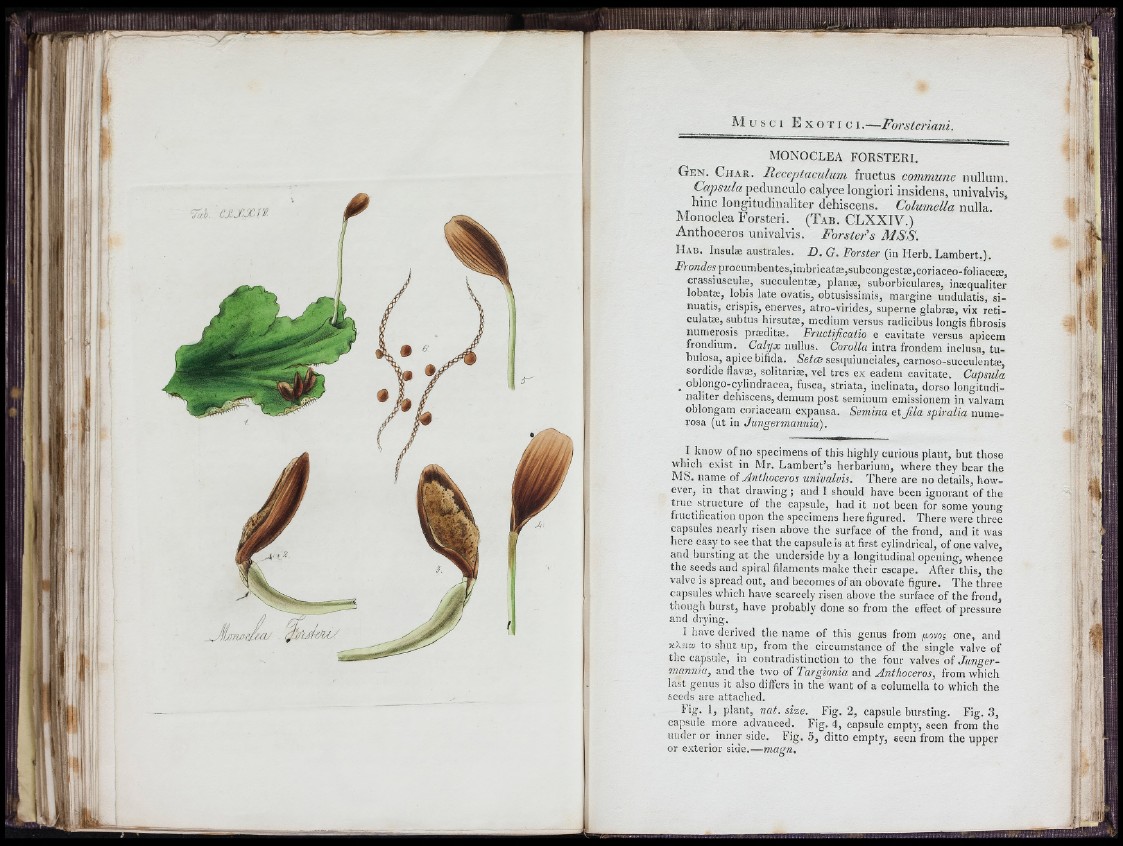
'■/u'h. í:j ! J [ X ív .
jfL m i-e É /jy ■
MONOCLEA FORSTERI.
Gen. Char. lieceptacidum fmctus commune nulluni.
Capsula pedúnculo calyce longiori insidens, univalvis,
hinc longitudinaliter dehiscens. Columella nulla.
Monoclea Forsteri. (Tab. CLXXIV.)
Anthoceros univalvis. Forster's AISS.
H ab. Insulas australes. D . G. Forster (in Herb. Lambert.).
Frowdeí procumbentes,inibricatæ,subcongestæ,coriaceo-foliaceæ,
crassiusculae, succulentæ, planæ, suborbiculares, inæqualiter
lobatæ, lobis late ovatis, obtusissimis, margine undulatis, si-
iiuatis, crispis, enerves, atro-virides, superne glabræ, vix reti-
culatæ, spbtus hirsutæ, medium versus radicibus longis fibrosis
numerosis præditæ. Fructificatio e cavitate versus apicem
frondium.^ Cab/x iiulliis. Coro(/a intra frondera inclusa, tubulosa,
apice bifida. Setoe sesquiuncialcs, carnoso-succulentæ,
sordide flavæ, solitariæ, vel tres ex eadem cavitate. Capsula
^ oblongo-cylindracea, fusca, striata, inclinata, dorso longitudinaliter
dehiscens, demum post seminum emissionem in valvam
oblongam coriaceam expansa. Semina e tfila spiralia numerosa
(ut in Jungermannia).
I know of no specimens of this highly curious plant, but those
which exist in Mr. Lambert’s herbarium, where they bear the
MS. name oï Anthoceros univalvis. There are no details, however,
in that drawing ; and I should have been ignorant of the
true structure of the cajisule, had it not been for some young
fructification upon the specimens here figured. There were three
capsules nearly risen above the surface of the frond, and it was
here easy to see that the capsule is at first cylindrical, of one valve,
and bursting at the underside by a longitudinal opening, whence
the seeds and spiral filaments make their escape. After this, the
valve is spread out, and becomes of an obovate figure. The three
capsules which have scarcely risen above the surface of the frond,
though burst, have probably done so from the effect of pressure
and drying.
I have derived the name of this genus from ¡.was one, and
jiXiio) to shut up, from the circumstance of the single valve of
the capsule, in contradistinction to the four valves of Junger-
inanma, and the two of Targionia and Anthoceros, from which
last genus it also differs in the want of a columella to which the
seeds are attached.
Fig. 1, plant, nat. size. Fig. 2, capsule bursting. Fig. 3,
capsule more advanced. Fig. 4, capsule empty, seen from the
under or inner side. Fig. 5, ditto empty, seen from the upper
or exterior side.—magn.
■ r I